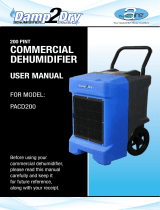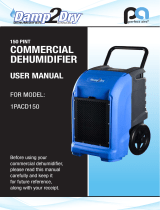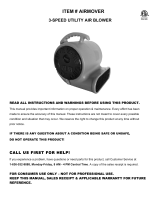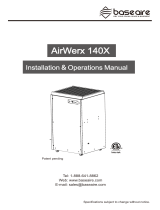Dri-Eaz 2000 LG User manual
- Category
- Dehumidifiers
- Type
- User manual
This manual is also suitable for

07
-
00265 F 3
-
02 Copyright 2000, 2002 Dri
-
Eaz Products, Inc.
Owner’s Manual – DrizAir Dehumidifiers
DrizAir 80, DrizAir 1200, DrizAir 2000 LG, DrizAir 2400 LG
115-volt models
DRI-EAZ PRODUCTS, INC.
15180 Josh Wilson Road, Burlington, WA USA 98233
Fax: (360) 757-7950 Phone: (360) 757-7776 www.dri-eaz.com
DrizAir Dehumidifiers are commercial refrigerant dehumidifiers, designed for drying building structures
and contents. They are designed for high performance water removal, as well as durability and ease of use.
Read And Save These Instructions
Safety Information
Keep Children Away: Do not allow children to play with or
around the unit, which could result in injury. Be sure the unit is
inaccessible to children when not attended.
Keep Unit Grounded: Always operate the unit with a grounding
plug and a grounded electrical outlet. A grounding plug is an
essential safety feature that helps reduce the risk of shock or
fire.
Protect Power Cord from Damage: Never operate a unit with a
damaged power cord, as this may lead to electrical or fire haz-
ards. If the power supply cord is damaged, it must be replaced
by a cord of the same type and amperage rating.
Extension Cords: Extension cords must be grounded and able
to deliver the appropriate voltage to the unit.
Handle With Care: Do not drop or throw the unit. Rough treat-
ment can damage the components or wiring and create a haz-
ardous condition.
Run on Stable Surface: Always operate the unit on a stable,
level surface, like the floor or a strong counter, so it cannot fall
and cause injury.
Secure During Transport: When transporting in a vehicle, se-
cure the unit to prevent sliding and possible injury to vehicle oc-
cupants.
Keep Out of Water: Never operate the unit in pooled or standing
water, as this may create a risk of injury from electrical shock. Do
not store or operate outdoors. If electrical wiring or components
become wet, thoroughly dry them before using the unit.
Keep Air Intakes Clear: Do not clog or block air intakes, as may
occur if operated to close to draperies or similar materials. This
may cause the unit to overheat and result in a fire or electrical
hazard.
Keep Filter Clean: Always use a clean air filter. Do not allow
any material to clog the filter, as this may cause the dehumidifier
to overheat. Do not allow oil, grease, or other contaminants to be
drawn into the dehumidifier.
Keep Electrical Components Dry: Never allow water inside the
dehumidifier's electrical components. If these areas become wet
for any reason, thoroughly dry them before using the dehu-
midifier.
Allow Repair Only by Qualified Person: Do not attempt to dis-
assemble or repair the unit if you are not qualified to do so. You
may handle some maintenance and troubleshooting, but make
sure that more complex problems are handled by an authorized
service technician. For information about authorized repair, call
Dri-Eaz at (360) 757-7776.
HOW TO USE DEHUMIDIFIERS
DrizAir Dehumidifiers are designed to reduce water vapor or high
humidity in a building or part of a building. The purpose is to pre-
vent humidity damage, and to dry out wet materials such as car-
pet, carpet cushion, floors, walls, furniture, contents, lumber, and
structural materials.
To speed up the rate of evaporation, and dry out materials faster,
use Dri-Eaz TurboDryer airmovers. The DrizAir Dehumidifier will
be needed to remove the additional water evaporated by the
TurboDryers.
Positioning Dehumidifiers
The dehumidifier must be operated in an enclosed area to
achieve best efficiency. Close all openings to other areas of the
building, like windows and doors, to prevent moist air from mix-
ing with the air in the drying area. Keep traffic through doors at a
minimum. This forms a closed drying chamber.
Inside the drying chamber, air should circulate freely. Open inte-
rior doors and operate TurboDryer airmovers to maintain good
airflow to all areas.
Place the dehumidifier where there is no restriction to air flowing
through either the inlet or the outlet. Keep away from loose mate-
rials like curtains and drapes.
Under normal circumstances, place the dehumidifier in the cen-
ter of the room. To dry a specific area, place the dehumidifier so
the outlet air points at the wet area and the warm, dry air passes
across it. The duct should never be closer than three feet from
the wall.
The DrizAir Dehumidifier warms the air as it removes its mois-
ture. In smaller rooms this can raise the temperature substan-
tially. Room temperatures of about 68° to 80° F (20° to 27° C)
are usually a good condition for drying. Never allow the room
temperature to exceed 100° F (38° C), because this could dam-
age the dehumidifier or building contents.
OPERATING INSTRUCTIONS
1. Operate the DrizAir Dehumidifier only in the upright position.
If it has been in a horizontal position for any time over a few
minutes, let it sit in the upright position for at least 30 minutes
before starting. This allows oil to drain back into the com-
pressor, increasing its life.
2. Plug in to a standard outlet with the correct voltage and am-
perage for the unit. Push the ON switch. Listen for proper
operation of fan and compressor before leaving the unit un-
attended.

Copyright 2000, 2002 Dri
-
Eaz Products, Inc. 2
3. Allow five minutes before restarting after the unit shuts off
for any reason. This will avoid damaging the compressor.
4. If your unit has a pump, run the pump drain hose into a sink,
toilet, drain, or bucket. Make sure the hose is not kinked. If
using a bucket, check and empty the bucket frequently to
prevent overflow.
5. Before moving the unit, make sure the pump is empty of wa-
ter. To do this, let the unit sit while OFF for 10 minutes, while
water drains drain from the coils into the pump. Then push
the PURGE switch. When using the DrizAir 80, tip the unit
backward to about a 30-degree angle; this will cause the
pump impeller to run and empty the collection pan.
6. CAUTION: Check dehumidifier daily for correct operation.
Protect floor surfaces from leakage.
Water Removal Rate
With all dehumidifiers, the rate of water removal varies with hu-
midity and temperature. If possible, judge the performance of the
dehumidifier by how much the humidity drops, rather than by the
volume of water being removed and deposited in the bucket. You
can roughly guess the humidity by its "feel" on your skin, but to
be accurate use a thermo-hygrometer.
To estimate how many dehumidifiers to place, see the Specifica-
tions below.
How the Machine Works
DrizAir units are refrigerant dehumidifiers. They operate by
blowing moisture-laden air from the room across a cold evapo-
rator coil. Moisture in the air condenses on the coil, drips off, and
then is removed through a drain hose or pump. Now warmer and
drier, the air passes back into the room to continue its work of
carrying water vapor.
When a DrizAir Dehumidifier is operating at a room temperature
below about 68° F (20° C), frost will normally form on the evapo-
rator coil. Water removal will stop temporarily. When an auto-
matic control built into the unit senses the ice temperature, it
initiates a defrost cycle. During this time, considerable quantities
of water drain from the unit. As soon as the ice has melted, nor-
mal operation resumes.
How to Use the Touchpad Controller
(DrizAir 1200, 2000, 2400 only)
The Touchpad Controller used on DrizAir dehumidifiers has one
display and four keys. The normal display messages are:
DEHUMIDIFIER OFF
DEHUMIDIFIER ON
TOTAL HRS=00000
JOB HRS=00000
CMPRSR DELAY 60
PUMP PURGING
DEFROST ON
GET SERVICE ER01
Control Keys
ON-OFF. When the unit is first plugged in, the display
cycles through three messages: DEHUMIDIFER OFF,
TOTAL HOURS , and JOB HOURS. Press the ON-OFF
key to turn the unit on. The display often reads CMPRSR
DELAY 00, with the numeral counting down from a
maximum of 60 seconds to 0. At that point the unit be-
gins to operate and the display reads DEHUMIDIFIER
ON. (The delay prevents damage from accidental power
interruptions, where power to the compressor stops and
then starts again when pressure in the system is still
high.)
PURGE. Push this key to run the purge before tipping
the unit. This empties water from the pump reservoir to
prevent leakage. If the unit has been operating, turn the
power OFF but leave the cord plugged in for about 10
minutes while water drips from the coil; then press
PURGE to remove residual water. The purge also runs
automatically every six minutes during operation, and
whenever the reservoir is full. While the purge is running,
the display reads PUMP PURGING.
DISPLAY. Press the DISPLAY key to stop the display at
DEHUMIDIFER ON or OFF, TOTAL HOURS, or JOB
HOURS, when it is cycling. Press again to make the dis-
play cycle again.
CLEAR. To clear the JOB HOURS reading, first press
the DISPLAY key to make the display read JOB HRS
steadily. Then press the CLEAR key to re-set the nu-
merals to 00000. NOTE: the TOTAL HOURS reading
cannot be re-set.
Defrost On
The display will read DEFROST ON whenever the unit is in a
defrost cycle. During normal operation, frost forming on the coils
is detected by the temperature sensor, causing a defrost cycle to
start. Dehumidification is suspended as hot gas flows through
the coils and melts the frost. At the end of the defrost cycle, the
display returns to its normal condition.
Changing Language Shown on Display
The default language is English. To change to another language,
follow these steps. (1) The unit must be unplugged from the
power outlet. Hold down the DISPLAY key while plugging the
unit in. The display now reads "ENGLISH." (2) Press the DIS-
PLAY key or the CLEAR key to adjust the reading to FRANCAIS,
DEUTSCH, or ESPANOL. (3) Then unplug the unit from the
power outlet, which sets the language.
CAUTION: While in the change-language mode, pressing other
keys can change operating parameters of the unit. Do NOT
press other keys or change parameters, except when following
guidelines from the Dri-Eaz Service Department.
Error Messages
In case of certain problems, the display may show the error
message "GET SERVICE," followed by "ER01" or another nu-
meral. Follow these steps:
1. First, unplug the unit and then plug it back in. This may re-
set the electronics.
2. If that does not fix the problem, try the solution if one is
listed in the table below.
3. If that does not fix the problem, contact the Dri-Eaz Service
Department ( contact information above).
ER
1-2-3-5-6
Problem with the electronic control panel.
Contact Service.
ER4 Problem with temperature sensor or cable.
ER8 Problem with a touchpad key. Press and release
each key several times.
ER9 Check for obstructions in pump or drain hose, or
that pump wiring is correct.
ELECTRICAL CONNECTIONS
DrizAir Dehumidifiers are designed to operate on a 115V/60 Hz
electrical connection. Make sure that the electrical outlet is
grounded and that all safety precautions are taken.
MAINTENANCE
Always turn off the power before performing maintenance proce-
dures. All the service procedures below are to be executed with
the unit unplugged. Perform before each use or as needed.
INSPECT ELECTRICAL SYSTEM: Inspect the electrical cord for
damage at regular intervals. Periodically, remove the housing
and inspect internal wiring for bare wires, insecure fasteners,
and discoloration. Remove and repair any damaged wiring as
needed. Failure to do so may lead to electrical shock or a fire
hazard.

Copyright 2000, 2002 Dri
-
Eaz Products, Inc. 3
PUMP TUBE: Make sure the pump tube is completely un-
wrapped and not kinked. Failure to do so can cause water to
back up in the pump and leak out. The control panel may signal
this problem by displaying “ER9.”
KEEP OUT DUST. Keep dust from drywall, demolition, and other
sources out of the coils. Failure to do so can cause the unit to
overheat, leading to compressor failure or other problems. Do
not run the unit during sanding, painting or other operations pro-
ducing airborne particulate. When dust is present, use the op-
tional pleated paper filter to keep more dust out of the unit; also,
inspect and clean the coils as required.
USE A CLEAN FILTER. Keep a clean filter in the unit at all times
to keep out dust. When using a foam filter, clean with a vacuum,
or wash with water and mild detergent and allow it to dry. When
using paper filters, discard the filter when visibly dirty and insert
a clean one.
SHINE EXTERIOR: Use a sponge and mild detergent for regu-
lar cleaning. Do not pour or run water onto the unit or allow wa-
ter to soak the touchpad control. Bring back the original shine
with a vinyl cleaner-polish.
Periodic Maintenance (as needed)
Make sure unit is unplugged. Remove housing as needed to
permit access to interior parts.
KEEP COILS CLEAN. Dirty coils do not remove water efficiently.
Inspect them regularly, especially if operating in dusty environ-
ments. Clean if they are visibly dirty.
First make sure coils are dry, then blow them clean with direct
compressed air from both sides of the coil. Do NOT hold too
close to the coils, as high-pressure air may fold the fins.
If sticky or oily residue remain, do a wet cleaning. Use a squirt
bottle to flush the coil with water and a little detergent. Do NOT
run a hose or pressure washer on the coils, or permit water to
enter the electrical compartment.
Remove dirt buildup with an aluminum evaporator coil cleaner
available from a refrigeration supply outlet. Follow product direc-
tions carefully.
When cleaning coils, also make sure that the drain tray, drain
hose, and filter cover are free of dirt.
PUMP SYSTEM: Inspect and clean the pump system regularly to
maintain effective operation. Remove the four screws holding
down the pump cover. Clean the catch basin. Make sure the float
shaft operates smoothly and does not stick in the OFF position.
Use a pipe cleaner to clean the gravity drain hose.
WARRANTY
FILL OUT WARRANTY CARD: Please stop before proceeding
and fill out the warranty card.
INSPECT ON ARRIVAL: When your Dri-Eaz product arrives,
check immediately for signs of shipping damage. If you notice
damage, save the shipping carton for claim purposes, and im-
mediately report the problem to your supplier and the shipping
company. Also, save the carton for shipping in case your product
ever needs repair at a remote location.
Dri-Eaz promises, to the original purchaser, to perform the
following as needed to correct defects in materials and
workmanship:
7 Years on Housing: Repair or replace the housing of a Dri-Eaz
Airmover or Dehumidifier, for seven years from date of purchase.
(United States and Canada only.)
4 Years on Compressor, Coils and Rotor: Repair or replace the
compressor and/or coil of a DrizAir Dehumidifier, or the desic-
cant rotor of a DriTec Dehumidifier, for four years from the date
of purchase. (United States and Canada only.)
1 Year on Parts and Labor: Cover parts and labor costs for the
repair of a Dri-Eaz Airmover, Dehumidifier, Instrument, Acces-
sory, and other product except Marketing Products, for a period
of one year from the date of purchase.
90 Days on Shipping: Cover shipping costs for the repair of a
Dri-Eaz Airmover, Dehumidifier, Instrument, Accessory, or other
product except Marketing Products, both to and from the Service
Center, for a period of 90 days from the date of purchase.
LIMITATIONS: This warranty shall not extend to any products
showing effects of misuse, accident damage, disassembly, al-
teration, lack of proper maintenance, corrosive chemicals, im-
proper voltage, unauthorized repairs, use of other than genuine
parts and materials, fire, flood, normal wear and tear, or any
other causes beyond Dri-Eaz Products' control. The warranty
obligation extends only to the repairs or replacement of parts
found, upon Dri-Eaz Products' examination, to be defective. The
foregoing constitutes the entire warranty and no other warranty,
liability, contingency or responsibility, direct, indirect, conse-
quential or in any way connected with the sale or operation of
products is expressed or implied.
TO RECEIVE WARRANTY SERVICE: You must write or call for
a Return Authorization. You must have the serial number avail-
able. The Dri-Eaz Service Department must authorize all costs,
including shipping, for any Service Centers worldwide. Please
direct questions to an authorized distributor, or to Dri-Eaz at
(360) 757-7776, extension 238.

Copyright 2000, 2002 Dri
-
Eaz Products, Inc. 4
SPECIFICATIONS
Model DRIZAIR 80 and 80 DX DRIZAIR 1200 DRIZAIR 2000 LG DRIZAIR 2400 LG
Water Removal,
maximum
80 pints
(10 gallons)
38 liters 123 pints
(15 gall.)
58 liters 198 pints
(25 gallons)
94 liters 240 pints
(30 gallons)
114 liters
Water Removal,
AHAM
40 pints
(5 gallons)
19 liters 64 pints
(8 gallons)
30 liters 110 pints
(14 gall)
52 liters 148 pints
(18.5 gall.)
70 liters
Airflow 200 cfm 360 cmh 225 cfm 385 cmh 365 cfm 700 cmh 365 cfm 600 cmh
Use Weight 62 lb (76 DX) 31 kg (39 DX) 80 lbs 36 kg 132 lbs 60 kg 160 lbs 73 kg
Dimensions 21x14x16 in
34x19x20 (DX)
53x36x41 cm
86x48x51 (DX)
32x20x20
in
83x50x50
cm
41x24x23
in
103x61x57
cm
47x24x27
in
120x61x6
9 cm
Operating range 55° - 95° F 13° - 35° C 33° - 100° F 0° - 38° C 33° - 100° F 0° - 38° C 33° - 100° F 0° - 38° C
Safety Listings UL, C-UL UL, C-UL UL, C-UL UL, C-UL
Filter Foam Foam or Paper Foam or Paper Foam or Paper
Defrost Thermostat – Fan Defrost Hot Gas Bypass Hot Gas Bypass Hot Gas Bypass
Pump Centrifugal (DX only) Centrifugal Centrifugal Centrifugal
Refrigerant R-134A R-22 R-22 R-22
Compressor 3,926 BTU Reciprocating 6,670 BTU Rotary 10,120 BTU Rotary 13,315 BTU Rotary
One dehumidifier will dry the air in APPROXIMATELY the size of the following drying chamber or room(s) with a standard ceiling.
Soaking wet 200 sq ft 20 sq meters 350 sq ft 30 sq m 550 sq ft 50 sq m 750 sq ft 70 sq m
Moderately wet 300 sq ft 30 sq meters 500 sq ft 45 sq m 825 sq ft 75 sq m 1,100 sq ft 100 sq m
Mostly dry 600 sq ft 60 sq meters 1,000 sq ft 90 sq m 1650 sq ft 150 sq m 2,200 sq ft 200 sq m
Specifications are subject to change without notice. Some values are approximate.
TROUBLESHOOTING
In COLUMN 3, "FS" or Field Solutions can be handled by the technician in the field. Others solutions should be handled by a repair technician –
an "AST" or Authorized Service Technician.
WARNING: All the service procedures below should be executed with the power turned off, i.e. unplugged.
PROBLEM CAUSE
See
above SOLUTION
Unit does not operate No power to machine FS Plug in the unit; check power at outlet
Switch not turned on FS Turn on the switch
Compressor will not start Unit needs 5 minutes before re-start FS Switch off unit, wait 5 minutes before starting
Overload preventing start up FS Reduce room temperature below 100° F (38° C)
Faulty or broken wire AST Replace or repair broken/loose wire
Defective relay AST Check relay with volt/amp meter
Compressor not running AST Contact distributor or Dri-Eaz Products
Blower wheel not turning Obstructed blower FS Remove obstruction
Loose blower wheel set screw FS Tighten set screw
Loose or broken wire AST Replace broken wire
Burned out fan motor AST Replace fan motor
Dehumidifier operating Not enough time to dry FS Allow more time for drying
but room not dry Poor air movement FS Increase air movement with TurboDryers
Excessive air infiltration FS Reduce airflow into the area being dried
Only partial frost Possible leak in system AST Check for leak with gas leak detector
or moisture on coils Low charge in system AST Repair and recharge system
No moisture Possible leak in system AST Check for leak with gas leak detector
or frost on coils Capillary tubing damaged AST Look for damage, replace tubing
Compressor not running AST Contact distributor or Dri-Eaz Products
Unit continuously in defrost Room temperature too low FS Increase room temperature
Defective control assembly AST Replace control assembly
Defective bypass relay valve AST Replace bypass valve
Unit does not defrost Defective sensor AST Replace sensor
(heavy frost or ice Defective control assembly AST Replace control assembly
persists over several hours) Defective bypass relay valve AST Replace bypass valve
Unit collects little water Room air too dry FS Check humidity with a hygrometer
Room temperature too low FS Increase the room temperature
Airflow through unit restricted FS Increase airflow; clean filter and coils
Pump does not function Stuck float valve FS Clean float valve shaft
FOR PARTS AND SERVICE CALL YOUR LOCAL DISTRIBUTOR,
or the Dri-Eaz Service Department at (360) 757-7776
-
 1
1
-
 2
2
-
 3
3
-
 4
4
Dri-Eaz 2000 LG User manual
- Category
- Dehumidifiers
- Type
- User manual
- This manual is also suitable for
Ask a question and I''ll find the answer in the document
Finding information in a document is now easier with AI
Related papers
-
Dri-Eaz DRI-104677 DrizAir 1200 Classic Refrigerant Dehumidifier User guide
-
Dri-Eaz Sahara Pro-HP Owner's manual
-
Dri-Eaz DrizAir F232-A GG Owner's manual
-
Dri-Eaz F203-A User guide
-
Dri-Eaz LGR1800 Owner's manual
-
Dri-Eaz Vortex Axial Fan Product information
-
Dri-Eaz TURBODRYER BALLOON Owner's manual
-
Dri-Eaz F351 User manual
-
LG 115V User manual
-
Dri-Eaz HVE-LL Large Loss User manual
Other documents
-
Impecca IDM72-SP User guide
-
 Damp2Dry PACD200 User manual
Damp2Dry PACD200 User manual
-
 Damp2Dry PACD150 User manual
Damp2Dry PACD150 User manual
-
 Pro-Series by Buffalo Tools 550672 User manual
Pro-Series by Buffalo Tools 550672 User manual
-
AlorAir Storm Pro User guide
-
Windsor AirMover 3 User manual
-
 BaseAire AirWerx140X Whole House Dehumidifier Removal 140 Pints at AHAM User guide
BaseAire AirWerx140X Whole House Dehumidifier Removal 140 Pints at AHAM User guide
-
SereneLife PDUMID95.5 Owner's manual
-
B-Air BA-VG-1500-BL-8 Owner's manual
-
B-Air Model BA-VG-1500-BL Owner's manual







